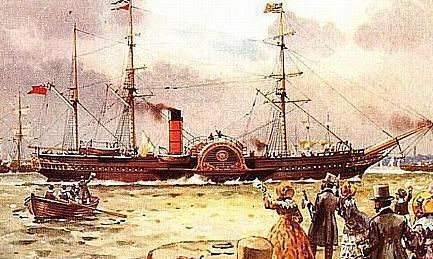Date 4 June 1849 | none none Result inconclusive | |
 | ||
1 sail corvette1 steamer 1 steam frigate2 steam corvettes Similar First Schleswig War, Battle of Bov, Battle of Isted, Battle of Fredericia, Battle of Heligoland Bight | ||
Battle of heligoland 1864
The first Battle of Heligoland took place on 4 June 1849 during the First Schleswig War and pitted the fledgling Reichsflotte (Imperial Fleet) against the Royal Danish Navy, which had blocked German naval trade in North Sea and Baltic Sea since early 1848. The outcome was inconclusive, with no casualties, and the blockade went on. It remained the only battle of the German fleet.
Contents
The events
At the outbreak of the First Schleswig War, the Danes instituted a blockade, stopping all German trade in the North Sea and the Baltic Sea. This prompted the German parliament at Frankfurt to form a new all-German navy. The Germans had to build a fleet from scratch, buying ships abroad and converting them, and hiring foreign officers (British, Belgian) to lead native veteran merchant mariners.
After about a year of preparation, on 4 June, German Admiral Karl Rudolf Brommy left Bremerhaven with the steam frigate SMS Barbarossa (formerly RMS Britannia) and the smaller steam corvettes Lübeck (1844) and Hamburg (1841) in order to disperse the Danish ships which were guarding the mouth of Weser River. The Danish forces present that day were inferior and retreated, but Brommy managed to cut off the sailing corvette Valkyrien which under captain Andreas Polder sought refuge near the island of Heligoland which at the time belonged to the United Kingdom. The British, while being neutral, had anyway made clear beforehand that a German Navy was not welcome and might be treated as pirates.
Ships of both sides fired some shots, with no effect. When the German approached the island's three-mile zone, the British forces fired warning shots towards them, while allowing the Danish corvette to stay close. Brommy, not willing to draw the Royal Navy into the war, stayed at a distance while the Danish captain Polder was waiting for the arrival of reinforcements from the Danish main fleet. When the modern steamer Gejser, under kaptajnløjtnant (captain lieutenant) Jørgen P. F. Wulff, came into sight, Brommy retreated, fearing further Danish reinforcements. The Danes followed the Germans to the mouth of the Elbe near Cuxhaven before resuming the blockade.
It was the first and the last excursion of the small fleet under the black-red-gold Flag of Germany.
